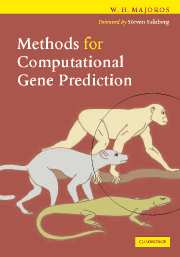Book contents
- Frontmatter
- Contents
- Foreword by Steven Salzberg
- Preface
- Acknowledgements
- 1 Introduction
- 2 Mathematical preliminaries
- 3 Overview of computational gene prediction
- 4 Gene finder evaluation
- 5 A toy exon finder
- 6 Hidden Markov models
- 7 Signal and content sensors
- 8 Generalized hidden Markov models
- 9 Comparative gene finding
- 10 Machine-learning methods
- 11 Tips and tricks
- 12 Advanced topics
- Appendix
- References
- Index
12 - Advanced topics
Published online by Cambridge University Press: 05 June 2012
- Frontmatter
- Contents
- Foreword by Steven Salzberg
- Preface
- Acknowledgements
- 1 Introduction
- 2 Mathematical preliminaries
- 3 Overview of computational gene prediction
- 4 Gene finder evaluation
- 5 A toy exon finder
- 6 Hidden Markov models
- 7 Signal and content sensors
- 8 Generalized hidden Markov models
- 9 Comparative gene finding
- 10 Machine-learning methods
- 11 Tips and tricks
- 12 Advanced topics
- Appendix
- References
- Index
Summary
We conclude with a brief exposition of current research topics in computational gene prediction. As these all are areas of active research in which the optimal computational methods have yet to be identified, our treatment will necessarily be provisional. It may be hoped that future revisions of this text will be able to treat these topics in a more decisive manner due to the fruits of current research.
Alternative splicing and transcription
It may reasonably be argued that most current attempts at computational gene finding – at least those based on Markov models and Viterbi decoding – are fundamentally flawed. The paradigm of gene finding, as we have formulated it, consists of computing the single optimal parse of a genomic contig, and then predicting the set of nonoverlapping gene structures present in this “optimal” parse. As briefly mentioned in section 1.4, however, it is known that most human genes are subject to the phenomenon of alternative splicing, whereby a single locus in the genome may give rise to several different mature mRNAs, and therefore (in many cases) to distinct proteins with potentially divergent biological functions. Some estimates place the incidence of alternative splicing among human loci as high as 80% (e.g., Matlin et al., 2005). Thus, the problem of alternative splicing is one of vital importance to a biological understanding of the human genome.
- Type
- Chapter
- Information
- Methods for Computational Gene Prediction , pp. 369 - 387Publisher: Cambridge University PressPrint publication year: 2007



